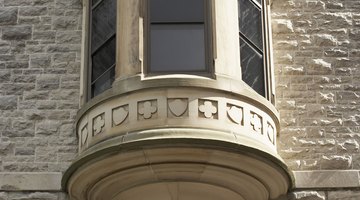How to Calculate the Square Footage of a Bay Window
Window bays project out from a wall and form an area distinct from the main part of the room. The shape varies according to the architectural style of the building; rectangular, semicircular, triangular and trapezoidal shapes are commonly used.

Calculating the square footage of a window bay, even an irregularly shaped one, is a straightforward task involving basic math and no previous building or decorating experience.
Things You Will Need
- Tape measure
- Chalk
- Tack pins
Tip
Stretching a string, or placing a wooden plank, across the line dividing the window bay from the main part of the room can make the task easier by providing the "missing" side of the bay. As with all measuring tasks, measure twice. Double-check the dimensions before using them.
Warning
Don't allow the separate areas to overlap or you will count parts of the floor more than once.
-
Divide the window bay floor into simple shapes, the areas of which are easily calculated. Envisage the overall shape broken into separate squares, triangles, segments of circles and rectangles.
-
Mark out the separate areas on the floor. Use chalk on hard floor surfaces and tack pins lightly pressed into carpets. For example, a square window bay with a narrowing and pointed end may be divided into a square and a triangle.
-
Calculate the area of each of the shapes within the bay using the following formulas: Area of a rectangle or square: Width x depth Area of any triangle: Half the depth x width Area of a semicircle: (Pi x radius squared) / 2 Area of a trapezoid: (shortest parallel side + longest parallel side)/2 x depth (Pi is a transcendental number usually shortened to 3.1415.)
-
Add together the individual areas to establish the overall floor area of the window bay. Using the example window bay consisting of a square and a triangle, if the square was 12 feet square and the triangle was 6 feet square, the square footage of the window bay would be 18 square feet — 12 + 6 = 18.
The Drip Cap
- Window bays project out from a wall and form an area distinct from the main part of the room.
- Calculating the square footage of a window bay, even an irregularly shaped one, is a straightforward task involving basic math and no previous building or decorating experience.
- Envisage the overall shape broken into separate squares, triangles, segments of circles and rectangles.
References
- University of Arkansas Division of Agriculture Cooperative Extension Service; Establishing a Lawn From Sod; Aaron Patton and John Boyd
- MathIsFun: Area Calculation Tool
- University of Wisconsin – Madison; The 15 Most Famous Transcendental Numbers; Cliff Pickover
- Flooring Supplies: How to Measure Your Floor
Writer Bio
David Robinson has written professionally since 2000. He is a Fellow of the Royal Geographical Society and the Royal Meteorological Society. He has written for the "Telegraph" and "Guardian" newspapers in the U.K., government publications, websites, magazines and school textbooks. He holds an honors Bachelor of Arts in geography and education and a teaching certificate from Durham University, England.
Photo Credits
- Jupiterimages/Photos.com/Getty Images
- Jupiterimages/Photos.com/Getty Images
More Articles



